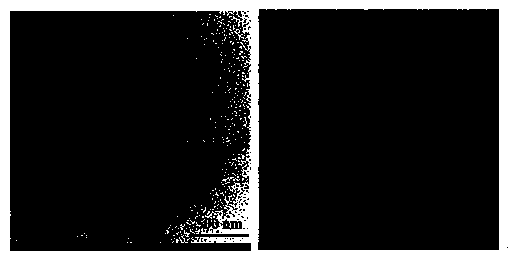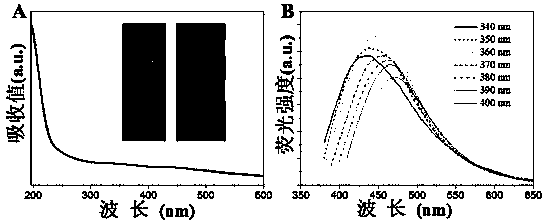Preparation method and application of fluorescence-MRI (Magnetic Resonance Imaging) dual-mode image probe
A dual-mode, probe technology, applied in the fields of nanomaterials and medical engineering, can solve the problems of short residence time, liver and kidney toxicity and side effects in clinical applications, and achieve simple reaction equipment, shortened longitudinal relaxation time, and excellent optical properties. Effect
- Summary
- Abstract
- Description
- Claims
- Application Information
AI Technical Summary
Problems solved by technology
Method used
Image
Examples
Embodiment 1
[0029] Dissolve 1 g of glycine and 1 g of gadopentetate meglumine in 20 mL of double-distilled water, and stir magnetically at room temperature to fully dissolve to obtain a uniform and transparent solution. Add the above solution to a household microwave oven (power; 700W) and heat it at high temperature for 1 minute. After the solution cools down naturally, filter it with a medium-speed filter paper to remove insoluble black precipitates. Centrifuge at 12,000 g for 30 minutes to remove large particles. Collect the supernatant and inject it into the Molecular Retention Dialysis was carried out in a dialysis bag with a capacity of 2000 Da. The dialysis time was 72 h, and the water was changed every 12 h. The dialyzed product was rotovaped to obtain a concentrated solution. The concentrated solution is freeze-dried at -50° C. to powder to obtain gadolinium-doped carbon quantum dots.
Embodiment 2
[0031] Dissolve 1 g of glycine and 2 g of gadopentetate meglumine in 20 mL of double-distilled water, and stir magnetically at room temperature to fully dissolve to obtain a uniform and transparent solution. Add the above solution to a household microwave oven (power; 700W) and heat it at high temperature for 4 minutes. After the solution is naturally cooled, filter it with a medium-speed filter paper to remove insoluble black precipitates. Centrifuge at 12,000 g for 30 minutes to remove large particles. Collect the supernatant and inject it into the Molecular Retention Dialysis was carried out in a dialysis bag with a capacity of 2000 Da. The dialysis time was 72 h, and the water was changed every 12 h. The dialyzed product was rotovaped to obtain a concentrated solution. The concentrated solution was freeze-dried to powder at -50°C to obtain gadolinium-doped carbon quantum dots (yield: 0.82%).
Embodiment 3
[0033] Dissolve 1 g of glycine and 3 g of gadopentetate meglumine in 20 mL of double-distilled water, and stir magnetically at room temperature to fully dissolve to obtain a uniform and transparent solution. Add the above solution into a household microwave oven (power; 700W) and heat it at high temperature for 6 minutes. After the solution cools down naturally, filter it with a medium-speed filter paper to remove insoluble black precipitates, centrifuge at 12000 g for 30 minutes to remove large particles, collect the supernatant and inject it into the molecular interception Dialysis was carried out in a dialysis bag with a capacity of 2000 Da. The dialysis time was 72 h, and the water was changed every 12 h. The dialyzed product was rotovaped to obtain a concentrated solution. The concentrated solution was freeze-dried to powder at -50°C to obtain gadolinium-doped carbon quantum dots (yield: 1.08%).
PUM
 Login to View More
Login to View More Abstract
Description
Claims
Application Information
 Login to View More
Login to View More - R&D
- Intellectual Property
- Life Sciences
- Materials
- Tech Scout
- Unparalleled Data Quality
- Higher Quality Content
- 60% Fewer Hallucinations
Browse by: Latest US Patents, China's latest patents, Technical Efficacy Thesaurus, Application Domain, Technology Topic, Popular Technical Reports.
© 2025 PatSnap. All rights reserved.Legal|Privacy policy|Modern Slavery Act Transparency Statement|Sitemap|About US| Contact US: help@patsnap.com



